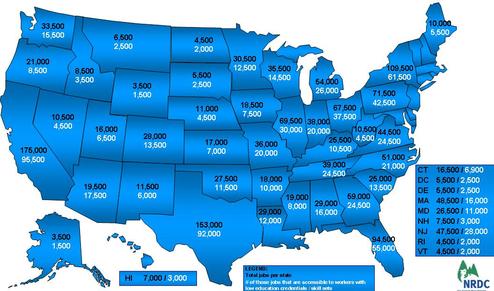The American Clean Energy and Security Act will help spur $150 billion in clean energy investments, which will create 1.7 million good-paying jobs throughout the United States.
Clean energy jobs are labor intensive, and clean energy investments create more jobs across all skill and education levels than comparable investments in fossil-fuel energy sources.
Clean energy investments create 3.2 times as many jobs as fossil-fuel investments overall. Among workers with few educational credentials and little work experience, clean energy investments create 5.5 times as many jobs as fossil-fuel investments. Furthermore, 75% of those clean energy jobs provide opportunities for advancement and higher salaries, enabling workers to lift their families out of poverty.
How would this job creation, and new opportunities for low-income families work out state-by-state? Based on recent reports by the Political Economy Research Institute, we mapped out job creation figures for total jobs created as well as the number of those jobs that are accessible to workers with low educational credentials or few jobs skills. On the map below, total job creation figures are in black, the low credential job figures are in white.
Total US job creation: 1,713,500 jobs. Of those, 871,000 would be accessible to those with low educational credentials and/or few job skills.
Sources:
“The Economic Benefits of Investing in Clean Energy” downloadable from http://www.americanprogress.org/issues/2009/06/clean_energy.html. “Green Prosperity: How Clean Energy Policies Can Fight Poverty and Raise Living Standards in the United States” downloadable from http://www.nrdc.org/energy/greenjobs/.
NRDC commissioned PERI to develop state-level figures for low-credential jobs for 21 states. Figures for remaining states were estimated by NRDC based upon the PERI data. For full methodology and explanation, see my original post.




